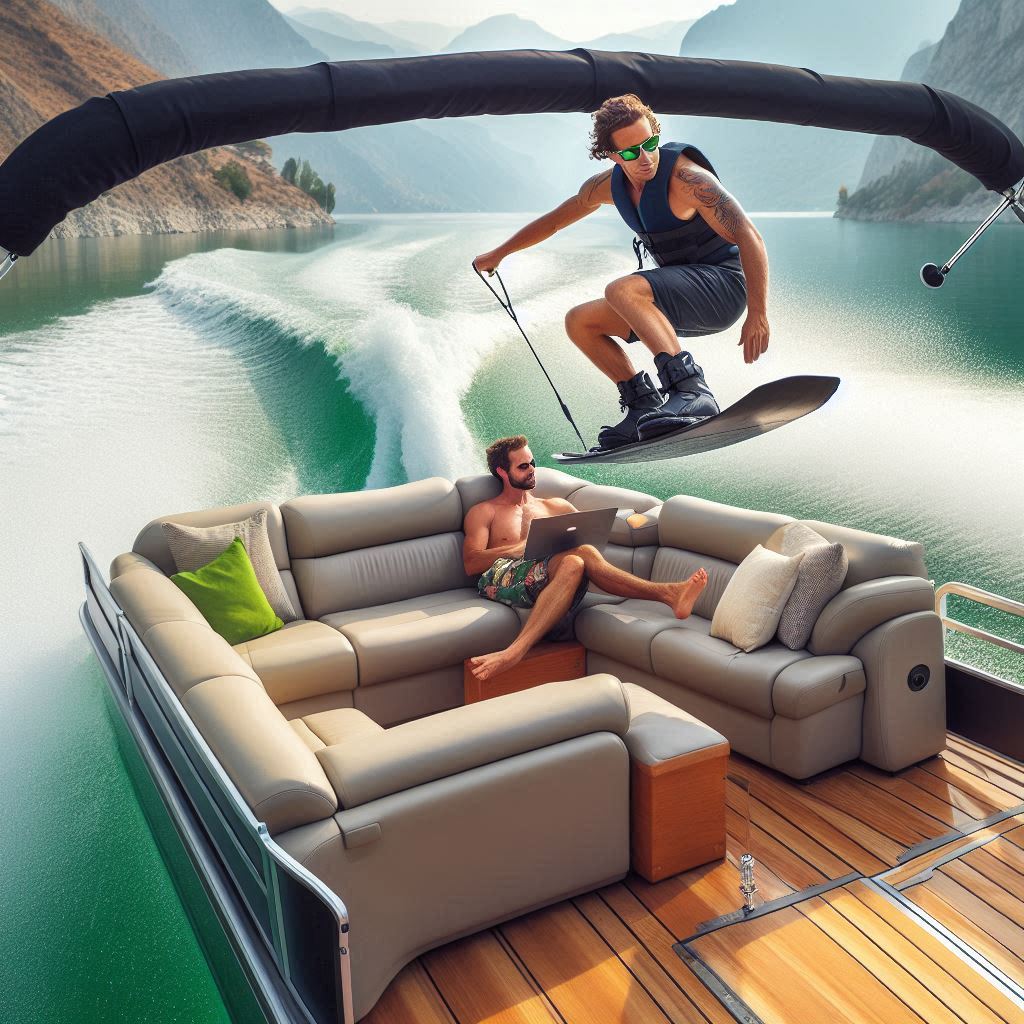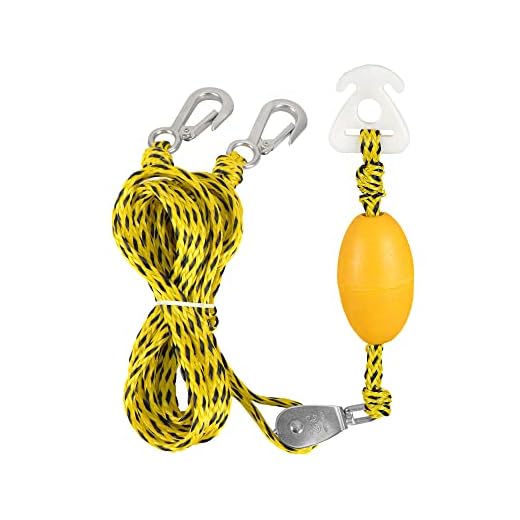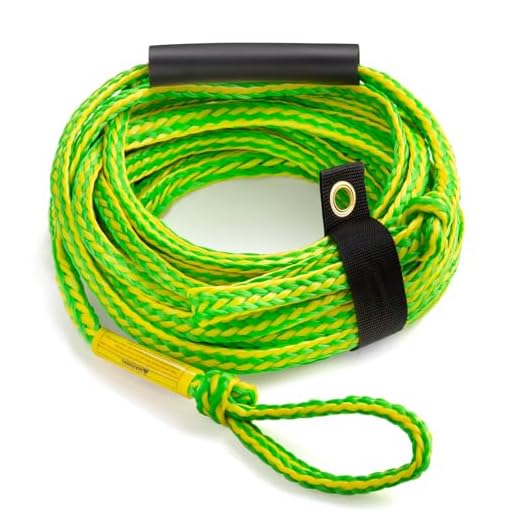Introduction to Pontoon Boats and Waterskiing
The Basics of Waterskiing
Waterskiing is a popular water sport where skiers are towed behind a motorboat or other watercraft while standing on skis. Waterskiing requires a combination of strength, balance, and skill, and it’s a thrilling activity for both beginners and experienced athletes.
Addressing the Question: Can You Ski Behind a Pontoon Boat?
The question of whether or not you can waterski behind a pontoon boat is a common one. The short answer is yes, you can ski behind a pontoon boat, but it’s important to understand the unique features and limitations of these vessels before hitting the water. In this article, we’ll explore the feasibility of skiing behind a pontoon boat, necessary equipment and preparations, tips and techniques for skiing safely, and important limitations and considerations to keep in mind.
The Feasibility of Skiing Behind a Pontoon Boat
Pontoon Boat Design and Waterskiing Compatibility
If you’re planning on waterskiing behind your pontoon boat, it’s important to know whether or not your pontoon boat is compatible with water sports. Most pontoon boats are designed for leisurely activities like cruising, fishing, and entertaining. Some pontoon boats are designed for water sports like waterskiing, wakeboarding, and tubing. These boats are equipped with features that make them more compatible with water sports activities. For example, they typically have a modified V-hull design that creates bigger waves and wakes for better performance and more fun on the water.
If you have a pontoon boat that isn’t designed for water sports, you can still use it for waterskiing, but you’ll need to modify it. One common modification is adding ski pylons or tow bars to the back of the boat. Ski pylons and tow bars are designed to elevate the tow rope so it doesn’t drag in the water and create drag.
PONTOON PRO REAR SKI TOW BAR TOWER, OUTBOARD MOTOR PYLON POLE, OVERALL WIDTH 43", TUBING SIZE 2.25" (Black)
Engine Power and Boat Performance
The amount of engine power your pontoon boat has will greatly affect its performance when towing a skier. A boat with a small engine will struggle to get skiers up out of the water, and may not be able to achieve sufficient speed for skiing. A boat with a powerful engine, on the other hand, will be able to get skiers up quickly and easily, and will have ample power to maintain high speeds.
If you’re planning on waterskiing behind your pontoon boat, make sure you have an engine with enough horsepower to support your activity. If you’re not sure what size engine you need, consult your boat’s manual or talk to a professional.
Evaluating Water Conditions for Skiing
The water conditions you’re in can greatly affect your ability to waterski behind a pontoon boat. Calm water is always best for waterskiing as it provides a smoother, more controlled ride. In choppy or rough water, a pontoon boat will not be able to create the same waves and wakes, and will be less stable than in calm water.
Before heading out, make sure to check the weather forecast and the current water conditions. Avoid waterskiing in areas with heavy boat traffic, as this can create choppy water and dangerous conditions for skiers.
Necessary Equipment and Preparations
Before hitting the water, it’s essential to ensure that you have the necessary equipment and preparations in place. The following are the essential equipment and preparations required for waterskiing behind a pontoon boat:
A. Safety Equipment for Skiing Behind a Pontoon Boat
Waterskiing behind a pontoon boat requires safety equipment, which includes:
| Safety Equipment | Description |
|---|---|
| Life Jackets | All passengers should wear approved life jackets to stay safe in case of accidents. |
| Flag | A visible flag is necessary to signal other boats when a skier is in the water. |
| Fire Extinguisher | Ensure a functioning fire extinguisher is onboard for emergencies. |
Hardcore Coast Guard Type III PFD for Adults; Life Jacket Paddle Vest for Adults; Life Vest Flotation Device; Jet ski, Wakeboard, Hardshell Kayak Life Jacket; Ideal Extra Life Jacket for Pontoon Boat
B. Choosing the Right Ski Equipment
Having the appropriate skiing equipment is critical in ensuring a successful ski behind a pontoon boat. Here are some tips:
- Water Skis – Use skis suitable for your skill level.
- Ski Rope – A high-quality, sturdy ski rope with handles is necessary to maintain balance while skiing.
- Wet-suit – A wet-suit is essential to protecting you from the cold water during skiing.
C. Prepping the Pontoon Boat for Waterskiing
Ensure that the pontoon boat is ready for waterskiing by doing the following preparations:
- Speed – Set the appropriate boat speed based on the water skiing level.
- Rearview Mirrors – Ensure that the driver has a clear view of the skier.
- Secure Equipment – Secure loose equipment before starting waterskiing.
With the necessary equipment and preparations in place, you are ready to enjoy waterskiing behind a pontoon boat safely and with confidence.
Tips and Techniques for Waterskiing Behind a Pontoon Boat
Waterskiing behind a pontoon boat can be a fun and exciting activity. However, it is important to follow certain techniques and best practices to ensure a safe and enjoyable experience.
A. Best Practices for Drivers
The driver plays a crucial role in ensuring a safe waterskiing experience. Here are some best practices for drivers:
- Make sure you have a clear and unobstructed view of the skier and the surrounding area.
- Keep the boat at a safe speed and maintain a consistent course.
- Be aware of other boats and obstacles in the water.
- Slow down and stop immediately if the skier falls or signals for a break.
- Communicate clearly with the skier through hand signals or a two-way radio.
B. Techniques for Skiers
Skiers should also follow certain techniques to ensure a safe and successful waterskiing experience:
- Choose the right ski equipment based on your skill level and the water conditions.
- Get in the proper position before starting, with your arms straight and your knees bent.
- Keep your weight centered over your skis and lean back slightly to stay upright.
- Communicate with the driver through hand signals or a two-way radio.
- Stay alert and aware of your surroundings, including other boats and obstacles in the water.
C. Handling Waves and Wakes
Waves and wakes can provide an exciting challenge for waterskiing behind a pontoon boat. Here are some tips for handling them:
- Approach waves and wakes at a slight angle to minimize their impact.
- Stay focused and maintain your balance by keeping your weight centered over your skis.
- Adjust your speed and direction as necessary to handle the waves and wakes.
By following these tips and techniques, you can have a safe and enjoyable waterskiing experience behind a pontoon boat. Just remember to always prioritize safety and follow best practices for a fun and successful outing.
Limitations and Considerations When Waterskiing Behind a Pontoon Boat
A. Limitations of Pontoon Boats
Pontoon boats are not built for speed – they are designed for leisurely cruising on the water. While it is possible to waterski behind a pontoon boat, it is important to recognize the limitations. Due to the boat’s size and shape, it may take longer to get up on skis, and it may not reach the speeds necessary for experienced skiers. It is also essential to ensure the boat’s weight does not exceed the recommended capacity, and the weight distribution is even for best performance.
B. Legal and Safety Considerations
Before embarking on any watersport activity, it is crucial to take into account local laws and regulations. In many areas, waterskiing is only allowed in designated areas and during specific hours. Besides, the boat operator and skiers must always wear personal flotation devices (PFDs) and keep a watchful eye for other boats and obstacles. It is also recommended to have a spotter on board to assist the driver and signal the skier in case of an emergency.
FAQs
Can you pull a tube behind a pontoon boat?
Yes, pontoon boats are suitable for pulling inflatable tubes and other towable devices. However, it is crucial to check the boat’s weight capacity, engine power, and the type of tube before attempting to pull it. Besides, make sure to follow safety guidelines and stay within designated areas for tubing activities.
What is the best engine size for towing skiers behind a pontoon boat?
The engine size needed to tow skiers behind a pontoon boat depends on several factors, such as boat size, weight, and number of passengers. However, a general rule of thumb is to aim for a minimum of 115 horsepower for a 20-22 feet boat and 150 horsepower for larger models. It is also essential to ensure the engine is in good condition and properly maintained.





















